
Melilla is an autonomous city of Spain in North Africa. It lies on the eastern side of the Cape Three Forks, bordering Morocco and facing the Mediterranean Sea. It has an area of 12.3 km2 (4.7 sq mi). It was part of the Province of Málaga until 14 March 1995, when the Statute of Autonomy of Melilla was passed.

An alfajor or alajú is a traditional confection typically made of flour, honey, and nuts. It is found in Argentina, Paraguay, the Philippines, Southern Brazil, Southern France, Spain, Uruguay, Peru, Ecuador, Colombia and Chile. The archetypal alfajor entered Iberia during the period of al-Andalus. It is produced in the form of a small cylinder and is sold either individually or in boxes containing several pieces.

Medina Sidonia is a city and municipality in the province of Cádiz in the autonomous community of Andalusia, southern Spain. Considered by some to be the oldest city in Europe, it is used as a military defence location because of its elevation. Locals are known as Asidonenses. The city's name comes from Medina and Sidonia and means "City of Sidon".
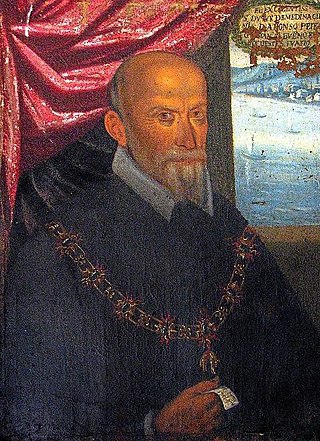
Alonso Pérez de Guzmán y de Zúñiga-Sotomayor, 7th Duke of Medina Sidonia, GE, was a Spanish aristocrat who was most noted for his role as commander of the Spanish Armada that was to attack the south of England in 1588. He was a great-great grandson of Ferdinand II of Aragon.
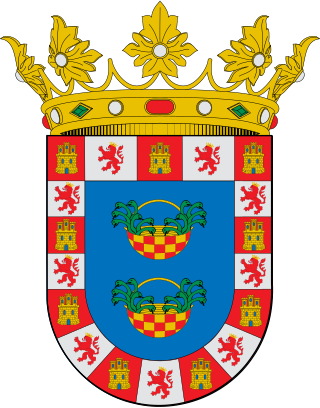
Duke of Medina Sidonia is a peerage grandee title of Spain in Medina-Sidonia, holding the oldest extant dukedom in the kingdom, first awarded by King John I of Castile in 1380. They were once the most prominent magnate family of the Andalusian region, the best-known of whom, Don Alonso Pérez de Guzmán y Sotomayor, 7th Duke of Medina Sidonia, commanded the Spanish Armada at the end of the 16th century. The defeat at the hands of weather and the English in 1588 brought disgrace to this family. The House of Medina Sidonia traces its descent from Alonso Pérez de Guzmán.
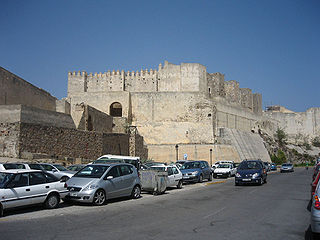
The Castle of Tarifa, also known as Castle of Guzmán el Bueno or Castle of the Guzmáns is a castle in the coastal town of Tarifa in Spain.

Luisa Isabel Álvarez de Toledo y Maura, 21st Duchess of Medina Sidonia, GE was the holder of the Dukedom of Medina Sidonia in Spain. She was nicknamed La Duquesa Roja or The Red Duchess due to her lifelong left-wing, anti-Francoist, pro-democracy political activism.
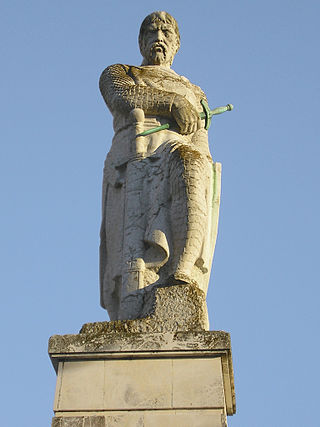
Alonso Pérez de Guzmán (1256–1309), known as Guzmán el Bueno, was a Spanish nobleman and hero of Spain during the medieval period, the founder of the line from which the Dukes of Medina Sidonia descend.

The House of Medina Sidonia is a Spanish noble house originating from the crown of Castile, whose name comes from the Duke of Medina Sidonia, a hereditary noble title that John II of Castile granted to Juan Alonso Perez de Guzman, 3rd Count of Niebla, on February 17, 1445, as a reward for his services to the crown. The Dukedom of Medina Sidonia is the oldest hereditary dukedom in the kingdom of Spain.

Zahara de los Atunes is a village on the Costa de la Luz of Spain in the province of Cádiz and the autonomous region of Andalusia. It is noted for its excellent beaches, an outdoor cinema, and la Iglesia Del Carmen church where, curiously, tuna were butchered and salted. Also in the town are excellent facilities including a variety of restaurants, cafes and hotels.
Juan Alonso de Guzmán y Suárez de Figueroa Orozco, 1st Duke of Medina Sidonia and 3rd Count de Niebla was a Spanish nobleman and military figure of the Reconquista.
Pedro Zoilo Téllez-Girón y Pérez de Guzmán, 8th Duke de Osuna, Grandee of Spain,, , was a Spanish nobleman.
Juan Manuel Pérez de Guzmán y Silva was a Spanish noble and 8th Duke of Medina Sidonia.

The Andalusian independentist conspiracy in 1641 was an alleged conspiracy of Andalusian nobility for Andalusia to secede from Spain. The conspiracy was brought to an end in summer 1641 after the plans of rebellion were discovered.
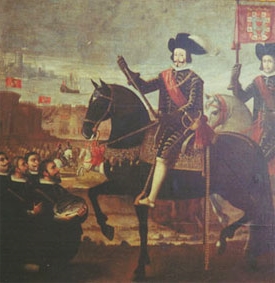
Gaspar Alfonso Pérez de Guzmán y Sandoval, 9th Duke of Medina Sidonia (1602–1664) was a Spanish nobleman who became Duke of Medina Sidonia in 1636, upon the death of his father Juan Manuel Pérez de Guzmán, 8th Duke of Medina Sidonia. He was one of the architects of the Andalusian independentist conspiracy (1641).
The eighth siege of Gibraltar (1462) was a successful effort by soldiers of the Kingdom of Castile to take the fortified town of Gibraltar from the Moors of the Emirate of Granada. Capture of this position, which was weakly defended and was taken with little fighting, was strategically important in the final defeat of the Moors in Spain.
Juan Alonso Pérez de Guzmán y Coronel (1285-1351), second lord of Sanlúcar, was a Castilian noble of the house of Medina Sidonia. He was the son of Alonso Pérez de Guzmán and María Alfonso Coronel. He defeated the troops of the King of Portugal in the Battle of Villanueva de Barcarrota (1336). He died in 1351.

The Señorío de Sanlúcar or Lordship of Sanlúcar was an independent Christian lordship in the Kingdom of Castile located in and around the modern day city of Sanlúcar de Barrameda. It was taken from the Kingdom of Granada in 1295.
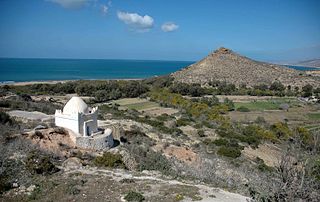
Cazaza was a Spanish enclave on the western coast of Cape Three Forks, in what is today Morocco, around 18 km from Melilla. It was here that the exiled Boabdil, last Emir of Granada, landed when he left the Iberian Peninsula in 1492.

The House of Guzmán is an old and noble Spanish family that emerged in Castile in the 12th century and became one of the most prominent dynasties of the Spanish kingdom until the 18th century. The original family gave rise to several branches, one of which became Dukes of Medina Sidonia from the 15th century to the 18th century, in turn giving rise to other branches including the Count-Dukes of Olivares.
















